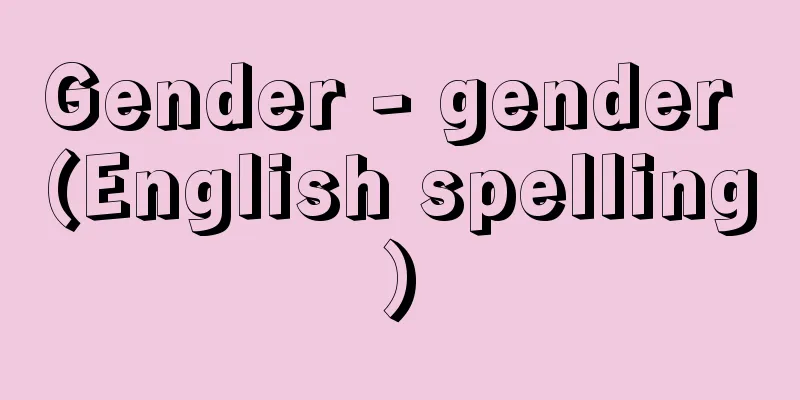Half-paid - Hanzei

|
During the Nanboku-cho Civil War, the Muromachi Shogunate paid half of the manor tax to certain provinces through the shugo as military food and rewards for their subordinate warriors for one year only. Originally, "hansei" meant paying half of the tax, and in other words, it meant a reduction or non-payment of the tax. An early example is the Into Manor in Shimousa Province (Inba County, Chiba Prefecture) in 1197 (Kenkyu 8), which was subject to the tax for the Katori Shrine's relocation, and there is a record of the manor paying rice as a counterpayment to the Katori Shrine's rice tax (Kamakura Ibun No. 960), and there are examples of this in manors in various regions after the 13th century. The Muromachi Shogunate's hansei system, which was implemented in conjunction with the practice of collecting military food rice during wartime, became a common system. In other words, when the Northern and Southern Court Civil War began, local shugo (military governors) in order to raise funds for the war and to pay rewards, and the Southern Court also carried out temporary requisitions under the name of choyobun (imperial share). This hit the lords of manors hard, and they asked the shogunate to stop it, but the shogunate continued to demand military expenses and reward land, putting them in a difficult position. In 1352 (Shohei 7, Bunwa 1), the shogunate promulgated the Half-tax Law, which set up shugo (military governors' association) for half of the main territories of the three provinces of Omi (Shiga Prefecture), Mino (Gifu Prefecture), and Owari (western half of Aichi Prefecture), which were strategically important at the time, and paid out these to their subordinate samurai through the shugo. The following year, the scope of enforcement was expanded to eight provinces. This half-tax law, which was originally intended to restrict the excessive establishment of military supply tax offices, became a reward land as the civil war dragged on, and furthermore, as seen in the half-tax order of 1368 (Shohei 23, Oan 1), the land was divided and half was owned by the manor lord and half by the stipend samurai. Later, during the Onin War (1467-77), both the eastern and western armies implemented half-taxes extensively, but the shugo, who held the right to manage the salaries of the half-taxed land, used this system as leverage to make reward land-like payments, leading to the dissolution of the manor system and promoting the daimyo domain system. [Jiro Shimada] "Miyagawa Mitsuru, 'The Dismantling of the Manor System' (included in 'Iwanami Lecture Series on Japanese History 7', 1963, Iwanami Shoten)" "Ogawa Makoto, 'The Northern and Southern Courts Civil War' (included in 'Iwanami Lecture Series on Japanese History 6, Middle Ages 2', 1975, Iwanami Shoten)" [Reference item] | |Source: Shogakukan Encyclopedia Nipponica About Encyclopedia Nipponica Information | Legend |
|
室町幕府が南北朝内乱に際して、特定の国に対し、守護を通じて荘園(しょうえん)年貢の半分を、その配下の武士の兵粮料(ひょうろうりょう)や恩賞として、1年に限って給与した制度。本来半済とは年貢などの半分を納済することをいい、いわば年貢などの減免・未進を意味するものである。早い例では1197年(建久8)香取(かとり)社遷宮作料を課せられた下総(しもうさ)国印東(いんとう)荘(千葉県印旛(いんば)郡)などで、その作料米を対捍(たいかん)して半済にしたという記録(『鎌倉遺文』960号)があり、13世紀以後各地の荘園でもその事例がある。制度的に一般化するのは、戦時に兵粮米を徴収する慣行と結び付いて行われた室町幕府の半済制度である。すなわち、南北朝内乱が始まると、各地の守護が戦費調達や恩賞給与のため、兵粮料所(りょうしょ)を濫設し、南朝側でも、朝用分(ちょうようぶん)と称して臨時の徴発を行った。これによって打撃を受けた荘園領主らは、幕府にその禁止を求めたが、幕府は引き続き軍費や恩賞地を求めざるをえず、窮地にたった。そこで1352年(正平7・文和1)幕府は半済法を公布し、当時戦略上の要地であった近江(おうみ)(滋賀県)、美濃(みの)(岐阜県)、尾張(おわり)(愛知県西半部)の3か国の本所領半分について、当年作に限り兵粮料所とし、これを守護を通じて国内の配下武士に給与した。翌年には施行範囲を8か国に拡大した。初め兵粮料所の濫設を制約するねらいをもったこの半済法も、内乱が長引くにつれて恩賞地化し、さらに1368年(正平23・応安1)の半済令にみられるように、下地を分割して荘園領主と給人武士が半分ずつ領有するに至った。その後応仁(おうにん)・文明(ぶんめい)の乱(1467~77)でも、東西両軍は広範に半済を実施したが、半済地の給与管理権を握る守護は、この制度をてことして恩賞地的給与を行い、荘園制を解体に導くとともに、大名領国体制を推進していったのである。 [島田次郎] 『宮川満著『荘園制の解体』(『岩波講座 日本歴史7』所収・1963・岩波書店)』▽『小川信著『南北朝内乱』(『岩波講座 日本歴史6 中世2』所収・1975・岩波書店)』 [参照項目] | |出典 小学館 日本大百科全書(ニッポニカ)日本大百科全書(ニッポニカ)について 情報 | 凡例 |
>>: Sailing ship - hansen (English spelling)
Recommend
Nine Old Men - Nine Old Men
...Subsequently, there have been rulings on uncon...
Naouji Isshiki
?-? A military commander during the Nanboku-cho p...
X-Colitis - X-Colitis
A disease of horses. Symptoms include sudden enter...
Mead, WR (English spelling)
…The most influential architectural firm in the l...
Botrydium divisum (English spelling)
…[Mitsuo Chihara]. . . *Some of the terminology t...
Training - Shugyo
As typified by the term "Buddhist training,&...
Acquired Resistance - Ability
...Such bacteria are called resistant bacteria, a...
Arsenate minerals - arsenate mineral
A salt mineral containing the arsenate radical (As...
Benishitaba (red underwing) - Benishitaba (English spelling) Catocala electa
An insect of the Noctuidae family of the Lepidopte...
Boreal wetlands
…In eastern Siberia, coniferous forests lose thei...
Amamiya Silk Mill
...A social movement aimed at improving women'...
Fusarium moniliforme (English spelling) Fusarium moniliforme
… Rice cultivation in humid regions of Japan was ...
Katsushuha Dam
...A city on the north bank of the Yangtze River ...
Impala subfamily - Impala aka
...All of them are native to Africa, and there ar...
Kiyohara Kiyohira - Kiyohara no Kiyohira
A military commander in the late Heian period. A p...






![Numakuma [town] - Numakuma](/upload/images/67cc74ccdfa9c.webp)


